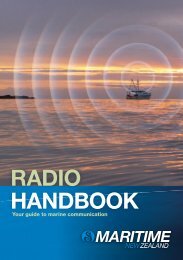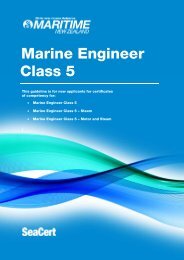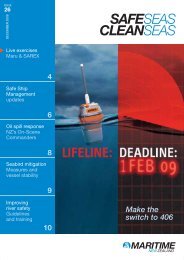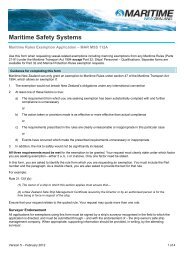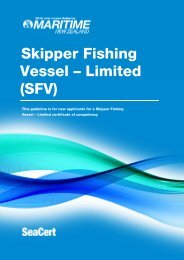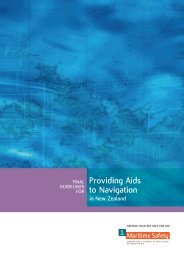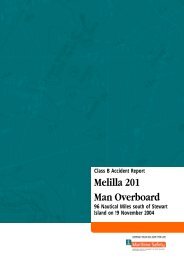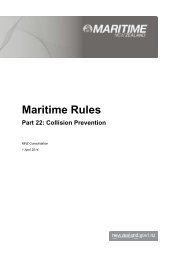New Zealand oil spill response strategy - Maritime New Zealand
New Zealand oil spill response strategy - Maritime New Zealand
New Zealand oil spill response strategy - Maritime New Zealand
You also want an ePaper? Increase the reach of your titles
YUMPU automatically turns print PDFs into web optimized ePapers that Google loves.
All vessels that meet the criteria specified by the MARPOL 73/78 convention (as reflected in Part 130A)<br />
are required to have a shipboard <strong>oil</strong> pollution emergency plan (SOPEP), approved and audited by<br />
<strong>Maritime</strong> <strong>New</strong> <strong>Zealand</strong> or the appropriate maritime authority for foreign flagged vessels.<br />
The owner of an <strong>oil</strong> transfer site is required to ensure that an approved <strong>oil</strong> <strong>spill</strong> contingency plan has<br />
been produced (either by themselves or their tenants or lessees). The regional council, acting under a<br />
delegation from the Director, will be responsible for approving and auditing the contingency plans for<br />
<strong>oil</strong> transfer sites.<br />
The owner of an offshore installation (or their tenants or lessees) is required to produce a marine <strong>oil</strong><br />
<strong>spill</strong> contingency plan. In addition, discharge management plans are to incorporate emergency<br />
<strong>response</strong> provisions for <strong>oil</strong> <strong>spill</strong>s. Both contingency plans and discharge management plans are<br />
approved and audited by <strong>Maritime</strong> <strong>New</strong> <strong>Zealand</strong>. Where there are a number of related structures in a<br />
limited and defined geographic area, such as a large hydrocarbon field, the same contingency plan<br />
under the emergency <strong>response</strong> provisions may be shared if appropriate.<br />
If a <strong>spill</strong> from a Tier 1 site cannot be contained and recovered by the <strong>spill</strong>er, it must escalate to the<br />
next appropriate Tier.<br />
Tier 2<br />
Tier 2 <strong>response</strong> is the responsibility of regional councils and those unitary authorities acting as<br />
regional councils under the Act. These agencies must maintain the regional contingency plan for their<br />
region.<br />
Within their regions, these councils will respond to marine <strong>oil</strong> <strong>spill</strong>s that exceed the clean-up capability<br />
of Tier 1 (some regions have instigated a policy whereby a Tier 1 incident automatically escalates to<br />
Tier 2 if <strong>oil</strong> enters waters in the public domain). They will also respond to those <strong>spill</strong>s for which no<br />
responsible party can be identified. <strong>Maritime</strong> <strong>New</strong> <strong>Zealand</strong> will provide regional councils with sufficient<br />
equipment, training and opportunities to exercise their expertise in order to competently undertake this<br />
role.<br />
Regional council Tier 2 personnel and resources also play a fundamental role in Tier 3 <strong>response</strong>s. In<br />
the event of a significant incident that escalates to Tier 3, the Tier 2 responders maintain the <strong>response</strong><br />
during the transition phase, and still form an integral and vital part of clean-up activities at the Tier 3<br />
level.<br />
Each regional council is required to produce, maintain and implement a regional marine <strong>oil</strong> <strong>spill</strong><br />
contingency plan for their Territorial Sea (out to 12 nautical miles). <strong>Maritime</strong> <strong>New</strong> <strong>Zealand</strong> will approve<br />
and audit these regional plans. The regional contingency planning process should also include pre<strong>spill</strong><br />
segmentation of the region’s coastline by suitable trained assessors, to identify homogenous<br />
segments and any associated <strong>response</strong> issues in advance of an incident.<br />
An opportunity now exists for most regional councils to link their contingency planning process to the<br />
risk assessments that should be undertaken every three years under the <strong>New</strong> <strong>Zealand</strong> Port and<br />
Harbour Marine Safety Code 2004. The Code, though voluntary in nature, stipulates that the region<br />
should undertake a risk assessment for all harbours and areas of compulsory pilotage within their<br />
jurisdiction. Risk assessment should form the basis and be a fundamental driver of contingency<br />
planning.<br />
The relationship between Tier 2 & 3 plans has undergone a significant evolution since the previous<br />
<strong>strategy</strong> in 2000. The structure of the plans has been redefined, so national and regional plans will<br />
contain uniform operational procedures. Regional Tier 2 plans will include specific local information in<br />
appropriate annexes. As <strong>Maritime</strong> <strong>New</strong> <strong>Zealand</strong> maintains the generic front end of the plan, regional<br />
councils can concentrate their resources on identifying and prioritising sensitive areas and local<br />
<strong>response</strong> issues.<br />
During an incident, if a <strong>spill</strong>er cannot be identified or if a <strong>spill</strong> is beyond the capability of the Tier 1 site<br />
to respond, the ROSC will assume responsibility for the clean-up operation within their region directly.<br />
The ROSC shall decide whether or not it is appropriate for any action to be taken in <strong>response</strong> to that<br />
marine <strong>oil</strong> <strong>spill</strong>. According to section 303 of the <strong>Maritime</strong> Transport Act, the principal objective of the<br />
ROSC in taking any such action will be to prevent further pollution from the marine <strong>oil</strong> <strong>spill</strong>, and to<br />
contain and clean up the <strong>oil</strong> <strong>spill</strong> in accordance with the relevant regional marine <strong>oil</strong> <strong>spill</strong> contingency<br />
12





